One of the most momentous events of the post-Jurassic world happened last week with the online release of the official trailer for the upcoming movie Jurassic World. Yet within mere hours of its release, a great wailing and gnashing of teeth arose from dinosaur nerdom, as professional paleontologists and fervent paleo-fangirls and paleo-fanboys alike jumped onto it like a ravenous pack of naked, oversized, bunny-handed velociraptors (or deinonychosaurs: whatever).
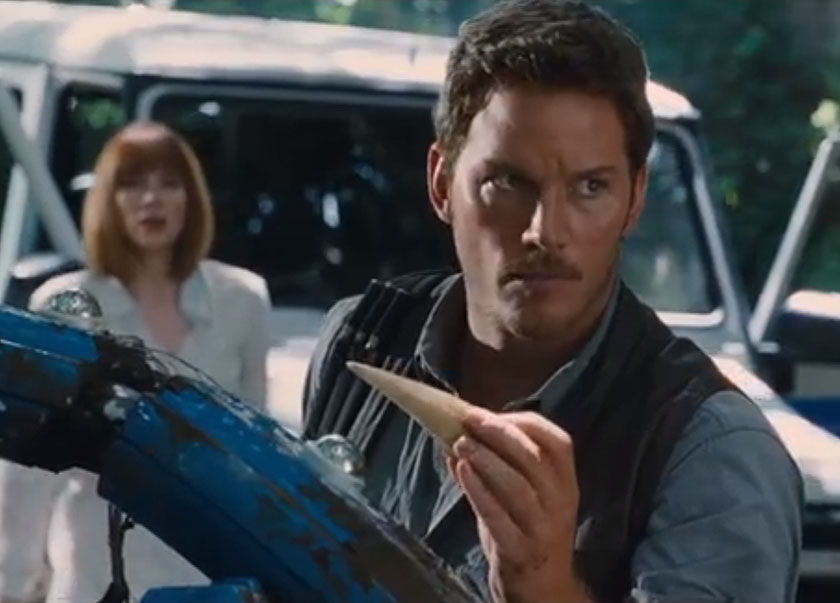 Owen (Chris Pratt): “Looks like a large theropod dinosaur tooth.” Claire (Bryce Dallas Howard): “That’s not going to tell us anything. Why don’t you look at its toothmarks right next to you?” That’s just one small sample of how I would rewrite the Jurassic World script from an ichnological perspective, neatly repairing its reputation as a scientifically accurate film while retaining blockbuster entertainment value. (This still image and all others in this post were stolen shamelessly from the Jurassic World trailer.)
Owen (Chris Pratt): “Looks like a large theropod dinosaur tooth.” Claire (Bryce Dallas Howard): “That’s not going to tell us anything. Why don’t you look at its toothmarks right next to you?” That’s just one small sample of how I would rewrite the Jurassic World script from an ichnological perspective, neatly repairing its reputation as a scientifically accurate film while retaining blockbuster entertainment value. (This still image and all others in this post were stolen shamelessly from the Jurassic World trailer.)
You see, this trailer – which lasted for all of 161 seconds – contained 257 scientific inaccuracies, which comes out to about 1.6 errors/second. OK, maybe I just made up that number, much like how some people make up movie plots, scripts, and characters. Nonetheless, the trailer had scenes depicting featherless theropods, elephant-skinned sauropods, and a non-dinosaur mosasaur that was far too big, had a frill on its back, and a non-forked tongue. It’s almost as if these were genetically recreated monsters, and not the original animals from the Mesozoic Era. Oh, the waste! Oh, the humanity!
Anyway, let’s talk about something that really matters, like traces. As far as I know – and like many others on the Internet, I plan to stay ignorant of anything that might add to my present knowledge – not one of those paleo-critics, or even the critics of the paleo-critics, mentioned the totally awesome and epic traces shown in this trailer. This egregious oversight once again reinforces my oft-asserted point that ichnology is the Rodney Dangerfield of paleontology.
So that’s why I’m here, to enlighten the masses and convert y’all to the Church of Ichnology, where there’s no tithing, dancing and drinking are required, and you can leave the church any time you feel like it. I’ve also covered this beat before, having reviewed the ichnology of Jurassic Park, which was an entire movie, not just a trailer. Even better, I know a little bit about dinosaur ichnology, having just written a book on that topic (Dinosaurs Without Bones, if you must know).
What traces in are in the trailer, you ask? The first ones shown are at 1:39, revealed with a shot panning up a concrete wall. There on the wall are sets of three more-or-less parallel scratches, some straight and some curved. The scratches vary in lengths, and a few cross-cut each another. In one set the scratches are not parallel, but form more of a fan pattern.
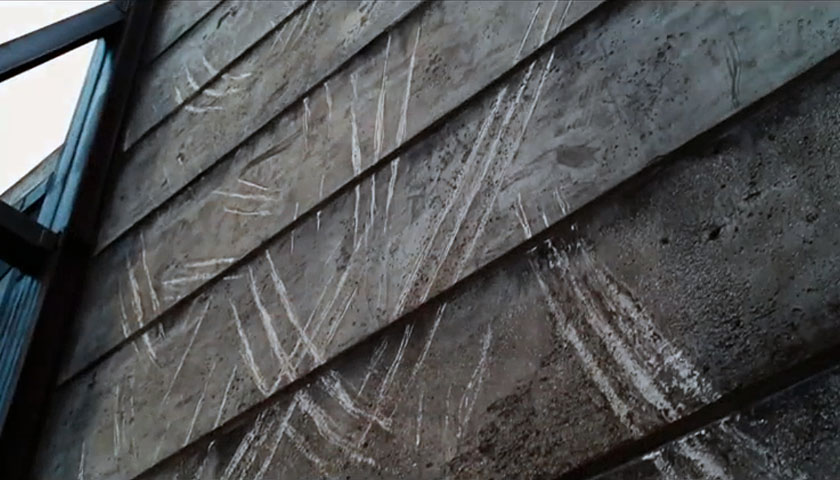 I knew it was worth sitting through the first 1:30 of this trailer – check out those scratch patterns!
I knew it was worth sitting through the first 1:30 of this trailer – check out those scratch patterns!
Of course, the preceding picture means little to an ichnologist unless it has a scale. I mean, were these from Compsognathus, or something a lot bigger? Fortunately, at 1:47, Chris Pratt provides a means of comparison by placing his hand on one of the scratches, and it looks like his three middle fingers approximate the width of that mark.
So let’s assume his hand proportions are about 1.4 times the size of mine, a supposition that can only be tested by the two of us having a beer together. (Hey, it could happen.) Accordingly, we will name this conversion factor the Chris Pratt Manual Ratio™ (CPMR). My three middle fingers bunched together are 5 cm (2 in) wide, which, after multiplying it by the CPMR, would make this scraping about 7 cm (2.75 in) wide. The spaces between the scratches seem to be about twice as wide, or 15 cm (5.5 in). This would make the entire set – three scratches and the two spaces between them – 51 cm (20 in) wide. These are twice as wide as some of the biggest known theropod dinosaur tracks. Or, as I like to say whenever I encounter grizzly-bear scratches on trees: “That ain’t no squirrel.”
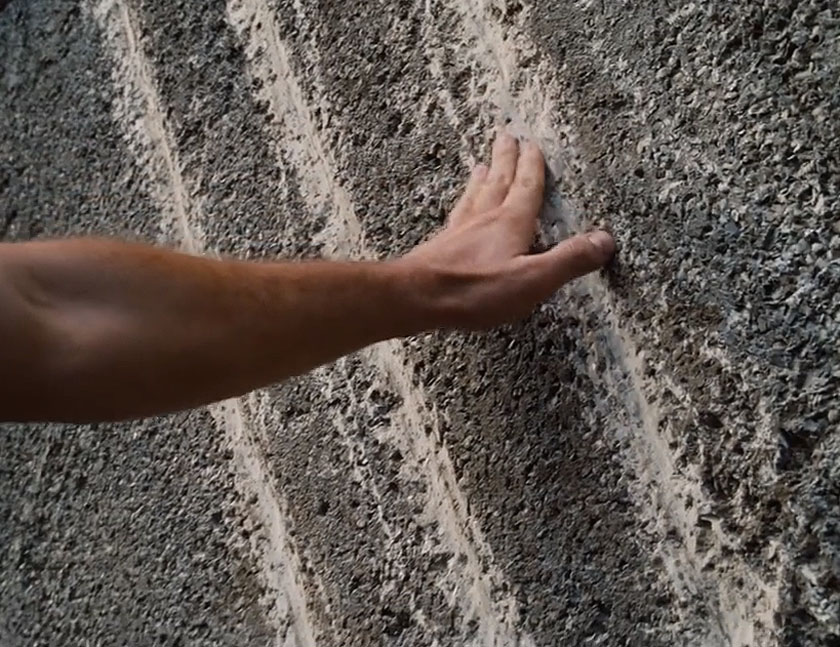 Put your hands on the traces, and feel their healing power and redemption! Repeat the Holy Trinity of the Church of Ichnology with me: Substrate, Anatomy, and Behavior! Amen, brothers and sisters!
Put your hands on the traces, and feel their healing power and redemption! Repeat the Holy Trinity of the Church of Ichnology with me: Substrate, Anatomy, and Behavior! Amen, brothers and sisters!
Based on my detailed study of these traces for at least two minutes (perhaps less), as well as Chris Pratt’s concerned gaze following these scracthes up the wall, I am interpreting them as traces made by three claws on the feet and hands of its tracemaker, with the wider sets coming from feet and the narrower ones from hands. Overall, these traces would be anatomically appropriate for theropod dinosaurs, many of which had three digits on its feet and hands with sharp claws. Moreover, this would have been a theropod dinosaur with impressively endowed forelimbs, sufficient for helping to pull it up a wall (sorry, T. rex).
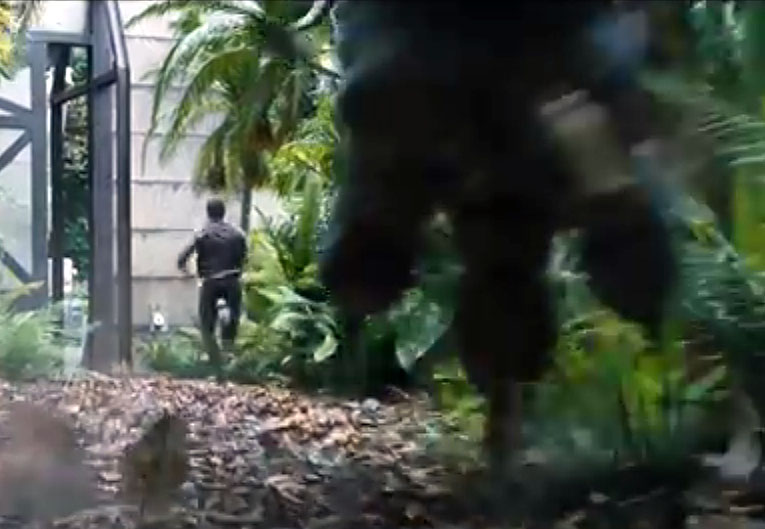 Why, that looks like an enormous three-toed foot with robust claws on their ends, and in motion as it chases the presumed protagonist of Jurassic World. Who could’ve predicted that, based on mere ichnologically based foreshadowing?
Why, that looks like an enormous three-toed foot with robust claws on their ends, and in motion as it chases the presumed protagonist of Jurassic World. Who could’ve predicted that, based on mere ichnologically based foreshadowing?
The behavior of the tracemaker can also be interpreted by looking for where the “feet” traces cross-cut the “hand” traces on the wall. This pattern would have been made by an upward movement of the tracemaker as it climbed the vertical surface. In short, these are escape traces, and they were made by a very large theropod-like dinosaur. To his credit, Chris Pratt’s character (“Owen”) totally got this.
 Chris Pratt isn’t just a Guardian of the Galaxy and a dinosaur handler: he’s also an ichnologist. (By the way: what’s with the bones behind him that don’t have any toothmarks on them? And why aren’t my paleontologist friends outraged about that unforgivable error?)
Chris Pratt isn’t just a Guardian of the Galaxy and a dinosaur handler: he’s also an ichnologist. (By the way: what’s with the bones behind him that don’t have any toothmarks on them? And why aren’t my paleontologist friends outraged about that unforgivable error?)
Any other traces in the trailer? Oh yeah, and it’s a good one. At 1:51, Bryce Dallas Howard (“Claire”) picks up a hardhat that clearly was not hard enough to prevent serious brain leakage in its former wearer. The trace is a sharply defined gouge that nearly cleaves the hardhat into two half-hats. This trace is either from a claw or tooth, but because it’s by itself, I’m going to surmise it was from a single strategically employed claw. How wide was the claw? We can figure that out by using the Bryce Dallas Howard Pollex Ratio™ (BDHPR) of 1.0, which assumes her thumb is the same width as mine, 2.2 cm (0.9 in). (Yes, I have petite thumbs. You have a problem with that?)
Based on this unit of measurement, the split seems to be at least three times her thumb width, or minimally 6.6 cm (2.6 in) wide. Which, incidentally, is about the same width as the scratches left on the concrete wall, which I also interpreted as coming from claws, and which neatly connects the escaped “dinosaur” to this heinous act committed on what was no doubt an out-sourced employee who did not have health insurance. Coincidence? No, it’s ichnology!
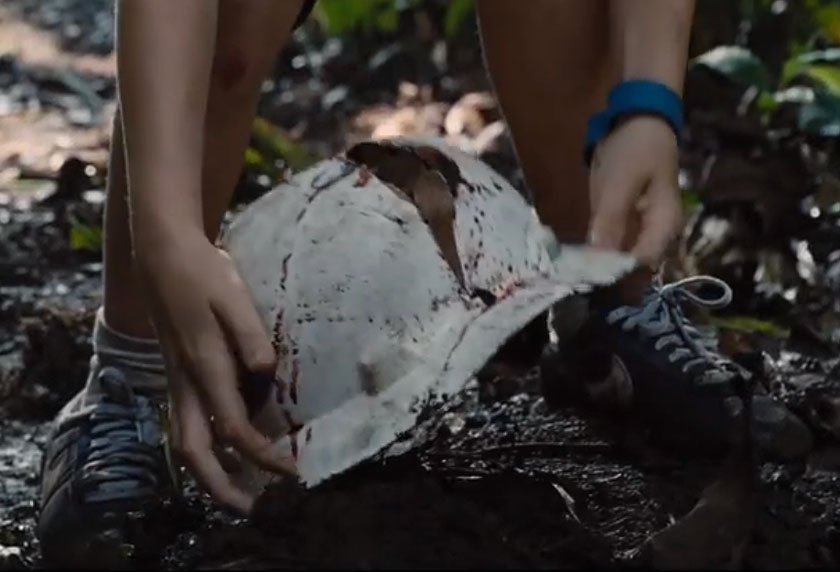 Hey, this hardhat is defective! Let’s check the warranty. Yup, sure enough: “Does not cover hybrid dinosaur attacks.” But at least we got a cool trace out of it.
Hey, this hardhat is defective! Let’s check the warranty. Yup, sure enough: “Does not cover hybrid dinosaur attacks.” But at least we got a cool trace out of it.
So despite all of the problems my paleontological colleagues justifiably noted for the dinosauroid animals depicted in the trailer, I am encouraged that Jurassic World will have enough ichnology in it to persuade me to leave a buttock-shaped impression on my theater seat in June 2015. But there had better be tracks, nests and feces in it, otherwise you’ll see my footprints going straight out of the theater.
(For other “ichnology at the movies” posts by Yours Truly, also check out The Ichnology of Pacific Rim and The Ichnology of Godzilla.)
